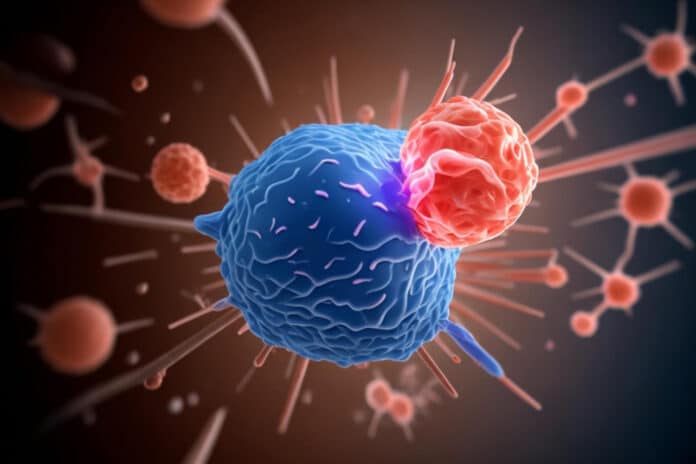Researchers from Memorial Sloan Kettering Cancer Center and Weill Cornell Medicine found the most important about cancer and our immune system. There’s a pathway in the immune system called the STING pathway that helps to fight off harmful things. But when cancer uses this pathway for a long time, it changes how it works. This change allows cancer to spread in the body.
Usually, the STING pathway helps the body to fight against things that could make it sick. But when cancer uses this pathway too much, it makes cells work differently, and this helps cancer grow and spread. This discovery could help to find new ways to stop cancer from spreading.
Samuel Bakhoum, MD, Ph.D., a researcher and radiation oncologist at MSK and one of the study’s two senior authors, said, “You might think of it like a car alarm. If it goes off rarely, that’s going to get your attention. But if it’s going off constantly, you’ll get used to it and tune it out.”
Researchers discovered why some medicines meant to help cancer patients failed. They looked at a STING pathway, which allows the body to fight cancer. These medicines were supposed to activate STING and help, but they didn’t do well in tests on patients.
Dr. Samuel Bakhoum, a researcher, said that “these medicines showed promise in the lab.” However, when tested on people, they didn’t work as expected. They wondered why.
They used a new tool to study how different cells interact in tumors. They found that when STING is activated for a long time, it attracts cells that stop the immune system from fighting cancer. It might be why the medicines didn’t work well. A team of Researchers did the study, using this new tool to understand better why these medicines didn’t show good results.
Dr. Bakhoum said, “It’s a feature of cancer, especially advanced cancers, where the normal process of cell division goes haywire. Chromosomal instability is an important driver of cancer’s ability to spread, otherwise known as metastasis. We discovered here that the immune system plays a central role in this process.”
Cancer cells and the immune system work together, guided by STING. Earlier, a study showed that dividing cells incorrectly makes cancer spread. But that study didn’t show how the immune system is involved.
In this new study, researchers used mice to learn more. They studied cancer in mice with weak and robust immune systems. They also looked at cells with different problems and the STING1 gene that helps with immune responses. They discovered that the immune system plays a significant role. Cancer cells with problems team up with immune cells because of STING. They found this out in mice and then checked human samples to be sure.
When they tried to activate STING in simple cells, there was a strong response from the immune system at first. But this response went away quickly. These cells got used to it and didn’t react the same way anymore. It was similar to what happened in cancer cells. Instead, the cells signaled something else that slowed down the immune response.
Cancer cells and the immune system work together, and STING is part of this cooperation. But when they tried to activate STING in normal cells, the immune response didn’t last. It helps to understand how cancer and the immune system interact.
The researchers used a unique way to study cells around a tumor. They wanted to know how different cells talk to each other. They used a technique called single-cell sequencing. It helps to understand all the different types of cells around the tumor, like immune cells and tumor cells.
These cells communicate by releasing things called ligands. These ligands stick to certain parts of other cells called receptors. It makes the target cell do something different. Usually, researchers predict cell communication based on whether these ligands and receptors match. But this research went further. Researchers wanted to know if this communication affects the target cell. They found out if the signal changed how the receiving cell behaved.
Dr. Laughney said, “One of our most important findings was that altering the level of chromosomal instability or the activation of STING dramatically changes responses in the environment in and around the tumor.”
Researchers wanted to understand how cancer cells and immune cells talk to each other. So, they created something called Contact Tracing to study this. They looked at how different cells interacted without knowing what was supposed to happen.
They found that not all cancer cells send the same signals, and not all immune cells can receive them. Contact tracing helped them see what changes happened when these cells talked.
For cells with problems during division, the tool showed that when they talked, it triggered a response that involved STING. This is why activating STING didn’t work well in these cases. But STING worked differently when they looked at cells without these problems, attacking the cancer cells. This new method could help in many other areas of science, too, where cells interact with each other.
These findings can help treat advanced cancer caused by division problems. Instead of activating STING, blocking it might be better. When they tested this on mice, it helped stop cancer from spreading. Also, doctors could use this information to find suitable patients for STING treatments.
Journal Reference:
- Li, J., Hubisz, M.J., Earlie, E.M. et al. Non-cell-autonomous cancer progression from chromosomal instability. Nature. DOI: 10.1038/s41586-023-06464-z.
